1000 targets in one C-25 salvo ("BERKUT") (SA-1 Guild)
The C-25 missile, designated B-300, was developed at the S.A. Lavochkin group P.D. Grushin, engine - at SRI-88 under the direction of A.M. Isaeva.
A single-stage rocket with a cruciform rudder and wing is made using an aerodynamic “duck” scheme - the plumage is in front and the wing is in the back. Case diameter - 0,71 m, length - 11,43, starting weight - 3405 kg. The LRE is adjustable, ranging from 2,5 to 9 t. The warhead on different versions was different - both in type and weight: from 235 to 390 kg. On the 207A, the first adopted modification, it was mounted with a 318 kg warhead, containing radially shaped shaped charges. When undermined, they formed a striking field in the form of a triangular-section disk with a divergence angle 6 °. The maximum speed of the rocket reached 3670 km / h. This was quite enough to defeat the intended targets - near-sound heavy bombers. The characteristics of C-25 missiles cannot be called unique, but for the USSR they were landmark in view of their novelty.
The radar, which received the index B-200, had two antennas forming wide flat rays. They were called “shovel-like” because their thickness was only about 1 °, and their width was 57 °. "Spades" were located in mutually perpendicular planes and fluctuated up and down and from right to left (or vice versa)
Anti-aircraft missile system "Berkut"
The main components of the S-25 air defense system: the V-300 missile and the B-200 radar (Museum aviation on the Khodynsky field in Moscow) © Tadeusz Mikutel - Skrzydlata Polska
The post-war transition in aviation to the use of jet engines led to qualitative changes in the confrontation of air attack and air defense weapons. The sharp increase in speed and maximum altitude of reconnaissance aircraft and bombers reduced the effectiveness of medium-caliber anti-aircraft artillery to almost zero. The release by the domestic industry of anti-aircraft artillery complexes consisting of anti-aircraft guns 100- and 130-mm caliber and radar weapons guidance could not guarantee reliable protection of protected objects. The situation was significantly aggravated by the presence of a potential adversary nuclear weapons, even a single use of which could lead to large losses. In this situation, along with jet fighters-interceptors, guided anti-aircraft missiles could become a promising air defense weapon. Some experience of the development and use of guided anti-aircraft missiles was available in a number of organizations of the USSR engaged in the development of German trophy rocket technology and the creation of domestic analogues on its base since 1945-1946. The development of a fundamentally new technology for the Air Defense Forces of the country was accelerated by the situation of the cold war. The plans developed by the United States for delivering nuclear strikes on industrial and administrative facilities of the USSR were supported by the build-up of the B-36, B-50 strategic bombers and other nuclear weapons carriers. The first object of anti-aircraft missile defense, which demanded the provision of reliable defense, was determined by the country's leadership to determine the capital of the state, Moscow.
The resolution of the USSR Council of Ministers on the development of the first domestic stationary anti-aircraft missile system for the country's Air Defense Forces, signed on August 9 on the 1950 of the year, was supplemented by the resolution of I.V. Stalin: "We must receive a missile for the air defense within a year." The decree determined the composition of the system, the parent organization - SB-1, developers and co-executive organizations of several industries. The developed anti-aircraft missile system was given the code name "Berkut".
According to the original draft, the Berkut system, located around Moscow, was to consist of the following subsystems and objects:
Two rings of the radar detection system (closest to 25-30 km from Moscow and farthest to 200-250 km) based on the Kama radar. The radar complex 10-centimeter range "Kama" for stationary radar nodes A-100 was developed by SRI-244, the main designer L.V. Leonov.
two rings (near and far) radar targeting anti-aircraft missiles. The cipher of the missile guidance radar is “product B-200”. Developer - SB-1, lead radar designer V.E. Magdesiev.
anti-aircraft guided missiles B-300, located on launch sites in the immediate vicinity of the radar guidance. The developer of the OKB-301 rocket, the General Designer is S.A. Lavochkin. Starting equipment was entrusted to develop GSKB MMP Chief Designer VP Barmin.
interceptor planes, cipher "G-400" - Tu-4 aircraft with G-300 air-to-air missiles. The development of the air interception complex was conducted under the leadership of A. I. Korchmar. Interceptor development stopped early. Rockets G-300 (factory code "210", developer of OKB-301) - a smaller version of the B-300 rocket with an air launch from an aircraft carrier.
Apparently, the D-500 long-range radar detection aircraft designed on the basis of the Tu-4 long-range bomber were supposed to be used as an element of the system.
The system included the grouping of anti-aircraft missile systems (regiments) with means of detection, control, support, a rocket weapons storage base, residential campuses and barracks for officers and personnel. The interaction of all elements was to be carried out through the central command post of the System through special communication channels.
The organization of work on the air defense system of Moscow "Berkut", carried out in the strictest degree
secrecy, was assigned to a specially created Third Main Directorate (TSU) at the USSR Council of Ministers. The head organization responsible for the principles of building the System and its functioning was determined by KB-1 - reorganized by SB-1, the main designers of the System were appointed PNKuksenko and S.L. Beria. For successful work in a short time, the necessary employees of other design offices were transferred to KB-1. German specialists brought to the USSR after the end of the war were also involved in the work on the system. Worked in various design offices, they were assembled in department No. 38 KB-1.
As a result of the hard work of many scientific and labor collectives, an experimental prototype of an anti-aircraft missile system, projects and samples of some of the main components of the system were created in an extremely short time.
The ground tests of the prototype version of the anti-aircraft missile system, conducted in January 1952, allowed to compile a comprehensive technical design of the Berkut system, which included only ground-based detection tools, anti-aircraft missiles and their guidance to intercept air targets from the originally planned composition of assets.
From 1953 to 1955 over the 50- and 90-kilometer frontiers around Moscow, the Gulag "special contingent" was building combat positions of anti-aircraft missile divisions, ring roads to ensure the delivery of missiles to fire divisions and storage bases (total length of roads to 2000 km) . At the same time the construction of residential towns and barracks. All engineering structures of the Berkut system were designed by the Moscow branch of Lengiprostroy, headed by V.I. Rechkin.
After the death of I. Stalin and the arrest of LP Beria in June 1953, the reorganization of KB-1 and the change of his leadership followed. By a government decree, the name of the Moscow anti-aircraft system "Berkut" was replaced with "System C-25", Raspletin was appointed chief designer of the system. TSU under the name Glavspetsmash included in the Minsredmash.
Deliveries of combat elements of the System-25 to the troops began in 1954, in March the equipment was set up at most of the facilities, and the components and assemblies of the complexes were adjusted. At the beginning of 1955, the acceptance tests of all complexes near Moscow ended and the System was put into service. In accordance with the Resolution of the USSR Council of Ministers of 7 in May 1955, the first connection of anti-aircraft missile forces proceeded to the phased implementation of the combat mission: to protect Moscow and the Moscow industrial area from a possible enemy air attack. The system was put on permanent combat duty in June 1956 of the year after an experienced duty with placement on the position of rockets without refueling with fuel components and with weight mock-ups of combat units. When using all the missile units of the system, simultaneous firing of air targets near 1000 at each target before the 3 missiles was principally possible.
After adopting the C-25 air defense system established over four and a half years into service, the Glavspetsmash headquarters: Glavspetsmontazh, which was responsible for the commissioning of the system's full-time facilities, and Glavspetsmash, which oversaw the development organizations, were eliminated; KB-1 transmitted to the Ministry of Defense.
To operate the C-25 system in the Moscow Air Defense District in the spring of 1955, the
A separate special forces army of the country's air defense forces under the command of Colonel-General K. Kazakov was deployed.
The training of officers for work on the System-25 was carried out at the Gorky Air Defense School, personnel - in a specially created training center - UTC-2.
In the course of operation, the System was improved with the replacement of its individual elements with qualitatively new ones. The C-25 system (its upgraded version - C-25М) was removed from combat duty in 1982, with the replacement of the anti-aircraft missile system by the average
C-ZOOP.
Anti-aircraft missile system C-25
Work on the creation of a functionally closed anti-aircraft missile system of the C-25 system was conducted in parallel along all its components. In October (June), the 1950 of the year was tested in an experimental prototype model of the SNR (Missile Guidance Station) B-200, and on July 25 1951, the first launch of the B-300 rocket took place on the test site.
To test the complete nomenclature composition at the Kapustin Yar test site, the following facilities were created: area No. 30 - the technical position of preparing C-25 missiles for launch; Site No. 31 - residential complex of the experienced personnel of the С-25 experimental system; ground № 32 - the launch position of the anti-aircraft missiles B-300; Site No. 33 - the prototype site of the CPR (Central Guidance Radar) C-25 (in 18 km from the site No. 30).
The first tests of a prototype of an anti-aircraft missile complex in a closed control loop (a polygon variant of the complex in full force) were carried out on November 2, 1952, when firing at an electronic simulation of a fixed target. A series of tests was conducted in November-December. The shooting at real targets - parachute targets was carried out after replacing the CRN antennas at the beginning of 1953. From April 26 to May 18, launches were carried out on Tu-4 target aircraft. A total of 18 of the year 1952 of the year 18 of the year 1953 of the year 81 was launched during the tests. In September-October, at the request of the Air Force Command, control ground tests were conducted when firing at Il-28 and Tu-4 target aircraft.
The decision to build a full-scale anti-aircraft missile system at the test site for re-conducting State tests was made by the Government in January 1954 based on the decision of the State Commission. The complex was presented to the State tests 25 June 1954 of the year, during which from 1 October to 1 April 1955, 69 launches were made on Tu-4 and Il-28 target aircraft. Shooting was conducted on radio-controlled target aircraft, including directors of passive jamming. At the final stage, 20 missiles were fired at 20 targets.
Prior to the completion of field tests, the production of spare parts for ZRK and missiles was connected to about 50 plants. From 1953 to 1955 years, the combat positions of anti-aircraft missile systems were built around 50 and 90-kilometer frontiers around Moscow. In order to speed up the work, one of the complexes was made head reference, it was put into operation by representatives of enterprise developers.
At the positions of the complexes, the station B-200 - (CRH), functionally connected with missile launchers, was located in a semi-submerged reinforced concrete structure designed for survival with a direct hit 1000-kg high-explosive aerial bomb covered with earth and disguised with grass. Separate premises were provided for high-frequency equipment, the multichannel part of the locator, the command center of the complex, the workplaces of operators and rest areas of duty shift shifts. Two antenna sightings of targets and four command transmission antennas were located in close proximity to the structure on a concrete pad. Search, detection, tracking of air targets and pointing missiles at them with each complex of the System were carried out in a fixed sector of 60 x 60 degrees.
The complex made it possible to accompany up to 20 targets for 20 firing channels with automatic (manual) tracking of the target and the missile aimed at it while simultaneously pointing the 1-2 missiles at each target. On each target firing channel at the launch position, there were 3 missiles on the launching pads. The time of transfer of the complex to combat readiness was determined by 5 minutes, during which time at least 18 of shooting channels had to be synchronized.
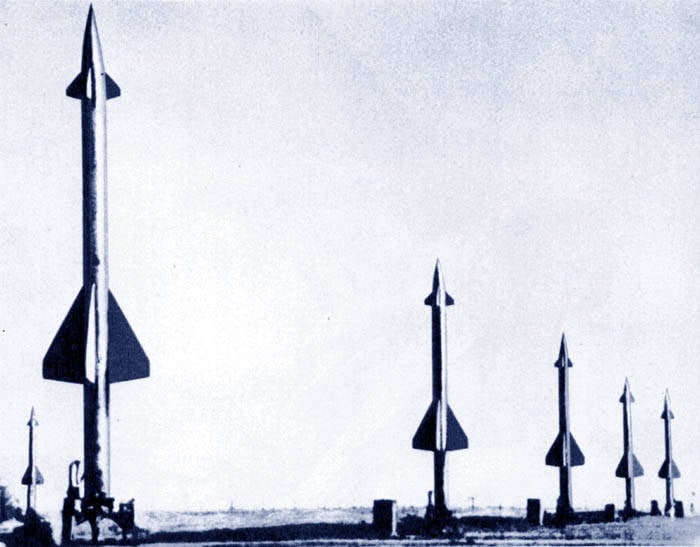
Combat position of B-300 missiles © Nevsky Bastion
Starting positions with launching tables six (four) in a row with access roads to them were located at a distance from 1,2 to 4 km from the CPR with the removal towards the division's responsibility sector. Depending on local conditions, due to the limited space available, the number of missiles could be somewhat less than the planned 60 missiles.
At the position of each complex were located facilities for the storage of rockets, platforms for the preparation and refueling of rockets, car parks, service and residential premises of personnel.
During operation, the system was improved. In particular, the equipment for the selection of moving targets developed in the 1954 year was introduced at the standard facilities after the ground tests in the 1957 year.
A total of X-NUMX C-56 series (NATO code: SA-25 Guild) in Moscow’s air defense system was manufactured, deployed and put into service; one serial and one experimental complex were used for field testing of instrumentation, missiles and equipment. One set of CRHs was used to test radio-electronic equipment in Kratovo.
B-200 missile guidance station
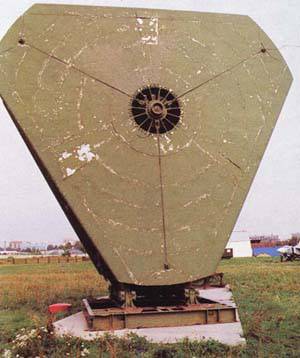 B-200 missile guidance radar (Aviation Museum on the Khodynka field in Moscow) © Tadeusz Mikutel - Skrzydlata Polska
B-200 missile guidance radar (Aviation Museum on the Khodynka field in Moscow) © Tadeusz Mikutel - Skrzydlata PolskaAt the initial design stage, the possibility of using narrow-beam radar accurate target tracking and a parabolic rocket antenna, which created two beams for tracking the target and the rocket aimed at it (V.M. Taranovsky), was investigated. At the same time, a variant of a rocket equipped with a homing head, which is being turned on near the meeting point, was worked out (Nikolai Viktorov, work manager). Works ceased at an early design stage.
The scheme for constructing a sector locator with linear scanning was proposed by MB Zakson, the construction of the multichannel part of the radar and its tracking systems for targets and missiles - KS Alperovich. The final decision on the adoption of sector targeting radars was taken in January 1952. An 9 m-high antenna and an 8 m azimuth antenna were placed on various bases. Scanning was carried out with continuous rotation of antennas consisting of six (two trihedral) beamformers each. Antenna scan sector - 60 degrees, beam width about 1 degrees. The wavelength is about 10 cm. In the early stages of the project, it was proposed to supplement the beamformers to full circles with non-metallic radio-transparent plates-segments.
When implementing a missile guidance station to determine the coordinates of targets and missiles, the "Method C" and the "AJ" electronic circuit proposed by German designers were adopted using quartz frequency stabilizers. The system "A" proposed by the employees of KB-1 on electromechanical elements and the "BZh" system - alternative to the "German" system were not implemented.
In order to provide automatic tracking of 20 targets and 20 guided missiles at them, the formation of control commands for the CRN, 20 firing channels were created with separate target tracking systems and rockets for each coordinate and an analog calculating device for each channel (developed by "Almaz", lead designer N.V. Semakov). Shooting channels were summarized in four five-channel groups.
For the control of missiles of each group, command transmission antennas were introduced (in the original version of the CPR, a single command transmission station was assumed).
An experimental sample of the CPR was developed from the autumn of 1951 of the year in Khimki, in the winter of 1951 and in the spring of 1952 in the territory of LII (Zhukovsky). A prototype of a serial CRR was also built in Zhukovsky. In August, the 1952 of the year, the CRP prototype was fully equipped. Control tests were conducted from 2 June to 20 September. To control the passage of the “combined” signals of the rocket and the target, the airborne transponder of the rocket was located on the BU-40 drilling rig, which was remote from the TsRN (in the standard version of the complex it was replaced with a telescopic structure with a radiating horn on top). Fast scanning (scanning frequency around 20 Hz) A-11 and A-12 antennas for the prototype station of the B-200 station were made at plant No. 701 (Podolsk Mechanical Plant), transmitters - in the radio engineering laboratory A.L.Minz. After the control tests were carried out in September, the CRN prototype was dismantled and sent by rail to the testing site to continue testing. In the autumn of 1952, a prototype of the CPR was built at the Kapustin Yar test site with the placement of instrumentation in a one-story stone building on the 33 site.
In parallel with the tests of the TsRN in Zhukovsky at the complex modeling stand in the KB-1, the missile guidance control target was tested.
The complex stand included simulators of target signals and missiles, their automatic tracking systems, a counting unit for the formation of command and control commands for the missile, on-board missile equipment and an analog computing device - a model of a missile. In the autumn of 1952, the stand was relocated to the landfill site at Kapustin Yar.
Serial production of TsRN equipment was carried out at plant number 304 (Kuntsevsky radar plant), antennas of a prototype of the complex were made at plant number 701, then for serial complexes at plant number 92 (Gorky Machine Building Plant). The control command transfer stations for rockets were made at the Leningrad plant of printing machines (production was later allocated to the Leningrad plant of radio engineering equipment), the counting-decisive instrumentation devices at the Zagorsk plant, electronic lamps were supplied by the Tashkent plant. The equipment for the C-25 complex was manufactured by the Moscow Radio Engineering Plant (MRTZ, before the war - the piston factory, later the cartridge factory - produced cartridges for large-caliber machine guns).
Adopted by the CRH differed from the prototype by the presence of control devices, additional indicator devices. From 1957 of the year, a moving target selection equipment was developed, developed in KB-1 under the guidance of Gapeev. For shooting at airplanes, jammers were introduced to the three-point guidance mode.
Anti-aircraft missile B-300 and its modifications
Designing the B-300 rocket (factory designation “205”, lead designer N. Chernyakov) was launched in the OKB-301 in September 1950 of the year. The guided missile variant was submitted for consideration at TSU 1 in March 1951, the draft design of the missile was protected in mid-March.
The rocket with a vertical launch, functionally divided into seven compartments, was equipped with radio command equipment of the control system and was made according to the "duck" scheme with the placement of rudders for pitch and yaw control on one of the head compartments. Ailerons located on the wings in the same plane were used for roll control. In the rear part of the hull, discharged gas rudders were attached, used to induce the rocket after launch towards the target, stabilize and control the rocket at the initial stage of flight at low speeds. Radar tracking of the rocket was carried out by the signal of the onboard radio response. The development of the autopilot of the rocket and the onboard equipment for the sight of the rockets - the receiver of the probing signals of the TsRN and the onboard radio-response machine with the generator of response signals - was carried out in KB-1 under the supervision of V.Е. Chernomordika.
The on-board radio equipment of the rocket was tested for command reception stability from the CRR using an aircraft that was patrolling the radar in the field of view and had onboard the rocket’s radio engineering units, control equipment. The onboard equipment of mass-produced missiles was produced at the Moscow bicycle factory (Mospribor plant).
Testing of the 205 rocket engine was carried out at the firing stand in Zagorsk (at present, Sergiev Posad). The performance of the engine and radio-technical systems of the rocket was tested under simulated flight conditions.
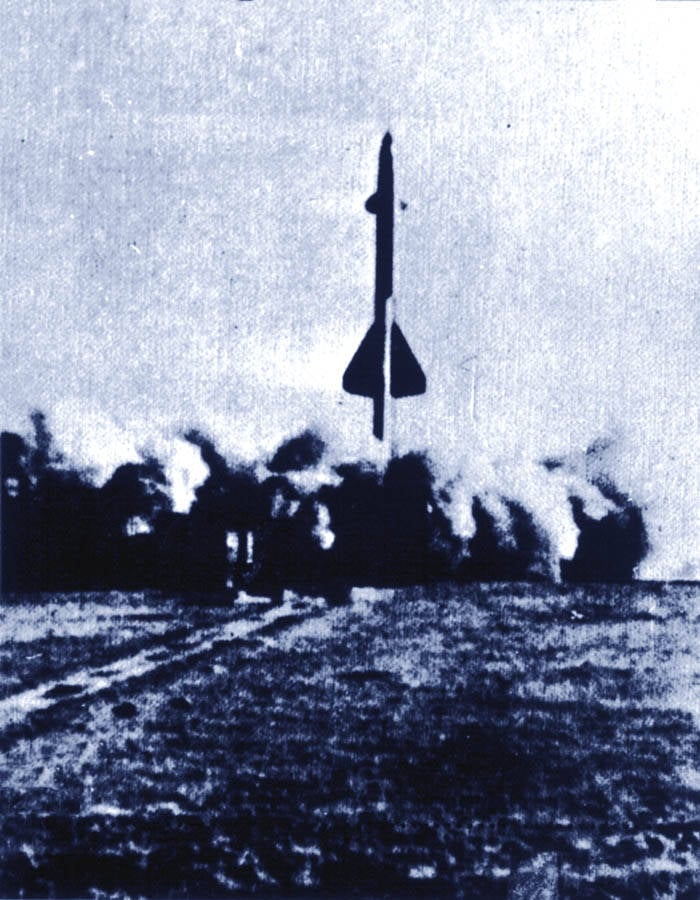
Training start of ZUR V-300
The first launch of the rocket was made on July 25 1951 of the year. The stage of ground tests to test the launch and stabilization system of the rocket (autopilot) took place in November-December 1951, with launches from the site 5 of the Kapustin Yar test site (the platform for launching ballistic missiles). At the second stage - from March to September 1952, autonomous launches of missiles were conducted. Controlled flight modes were checked when specifying control commands from the software bortotsy mechanism, later from equipment of similar standard equipment of CRN. During the first and second stages of testing conducted 30 launches. From 18 to 30 of October, five missile launches were carried out, captured and accompanied by the equipment of the CRN prototype test site.
After completion of the onboard equipment 2 on November 1952, the first successful launch of the rocket in a closed control loop (as part of an experimental ground version of the complex) took place when firing at an electronic simulation of a fixed target. The 25 of May 1953 was shot down by a T-300 target aircraft for the first time with a B-4 rocket.
In view of the need to organize in a short time mass production and delivery for conducting field tests and to the troops of a large number of missiles, the production of their experimental and serial variants for the C-25 system was carried out by 41,82 (Tushino Engineering) and 586 (Dnipropetrovsk Engineering).
The order to prepare the serial production of B-303 anti-aircraft missiles (B-300 rocket version) at the DMZ was signed on August 31 of the year 1952. March 2 1953 was tested four-chamber (two-mode) sustainer LNX С09-29 (with kg 9000 thrust with displacement
supply of hydrocarbon fuel and oxidant - nitric acid) design OKB-2 NII-88 Chief Designer AM Isaev. The fire tests of the engines were carried out on the basis of the NII-88 branch in Zagorsk - NII-229. Initially, the production of C09.29 engines was carried out by the pilot production of SKB-385 (Zlatoust) - now KBM them. Makeev. Mass production of missiles deployed DMZ in 1954 year.
Airborne missile power sources were developed at the State Research Institute of State Planning under the direction of N. Lidorenko. The combat units of the E-600 (of various types) B-300 missiles were developed at the Scientific Research Institute-6 MSKhM in collectives under the guidance of N. S. Zhidkikh, V. A. Sukhikh and K. I. Kozorezov; radio bakers - in KB, led by Rastorguev. A high-explosive fragmentation warhead with a radius of destruction of 75 meters was adopted for serial production. At the end of 1954, State tests of the rocket with a cumulative warhead were conducted. In some sources, a variant of the missile warhead is presented, which, according to the principle of operation, resembles an 76-mm antiaircraft projectile of the 1925 model:
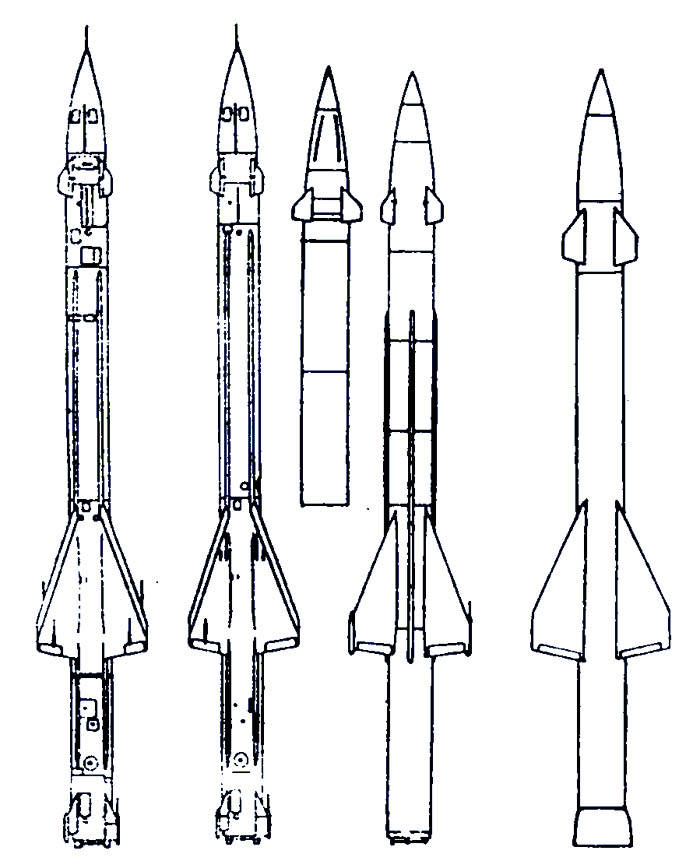
Anti-aircraft missiles and target rockets of the С-25 complex © S.Ganin, Nevsky Bastion
During the long-term operation of the C-25 system and its modifications, 205, 207, 217, 219 rockets of various variants were developed and used, developed by the OKB-301 and Burevestn ICD.
The development of the rocket "217" with LRE C3.42A (with 17000 kg with a turbo-pump fuel supply system) designed by OKB-3 SRI-88 of Chief Designer D.Sevruk began in 1954 year. Flight tests of the rocket were conducted from 1958 year. The modified version of the 217М rocket with the C.5.1 engine developed by OKB-2 (with the 17000 kg barge, with the turbo-pump fuel supply system) was adopted as part of the C-25M complex.
The 207T and 217T missiles were designed to repel massive enemy attack air raids. The 217T missile has been tested at the Sary-Shagan test site.
For practicing the skills of transporting and installing rockets on launching tables, industry produced weight and weight models of rockets of various variants and special variants of rockets for mining refueling.
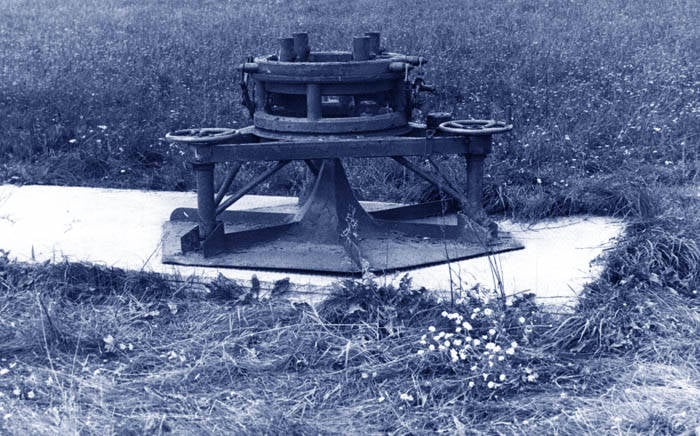
Launch pad for rocket "208" (Aviation Museum at Khodynskoye Pole in Moscow) © Nevsky Bastion
The transport starting equipment was developed in the GSKB MMP under the guidance of V.P. Barmin. Starting table - a metal frame with a conical flame diffuser and a device for leveling, was mounted on a concrete base. The rocket was mounted in a vertical position on the launch pad with four clamps located on the bottom cut around the rocket engine nozzle. During the inspections and pre-launch preparation, the power supply on board the rocket was supplied by cable through a quick-release onboard connector. The transport installer was located in a combat position at the launch pad. For transportation of missiles on the installers used truck tractors ZIL-157, later - ZIL-131.

Transport installation machine © S.Ganin, Nevsky
Bastion For the first time, the ZN-X X-Zx missile system was openly displayed at the November 300 7 military parade of the year, and for two and a half decades it opened the parade calculations of anti-aircraft guided missiles of the country's Air Defense Forces.
In KB-1, the 32 department, under the leadership of D.L.Tomashevich, for the C-25 air defense system, the 32B rocket with an inclined launch, equipped with a solid-fuel accelerator, was created and tested. The on-board equipment and the autopilot of the rocket were also developed in KB-1. The first prototypes of the rocket were delivered to the "A" test site at the end of 1952. The missile tests of the missiles were carried out when they were accompanied by the CRR using the signal reflected from the hull. To speed up work on the rocket and to ensure the complex testing of the rocket as part of the experimental complex of the Berkut system, KB-1 is assigned to plant No. 293 in Khimki. After the tests of the missile (when accompanied by the CPR at the signal of the defendant) in 1953, work on the use of 32B as part of the C-25 complex was discontinued. Considered the possibility of using missiles for mobile air defense systems. Department number 32 at the end of 1953 was transferred to plant number 293 and separated into an independent organization, OKB-2 Glavspetsmash. PDGrushin, the deputy S.A.Lavochkin, was appointed the head of the OKB.
C-25M system
In the middle (the 60-x of the guides, the Moscow air defense system C-25 was upgraded in the R.1C part, the missiles and received the designation C-25М.
Missile targeting equipment and calculating devices of a modified version of the B-200 station were performed purely electronic without the use of electromechanical elements.
217M rockets (tested in 1961 year); 217MA; 217МВ for the upgraded version of the system developed by the ICB "Petrel". In order to ensure the reliability of the launch position during repeated launches from each launching table of the SRI-2 GKAT, in 1961, the impact of the launch jet of the 217М rocket on the launch pad and the foundation of the launch pad of the system were studied.
The C-25M system complexes were removed from combat duty in 1982 with replacement of the C-300П system complexes.
Options for the development and use of the C-25 System
On the basis of the C-25 "Berkut" system, a prototype model of a complex with a simplified composition of equipment was developed. The antennas of the complex were located on a KZU-16 anti-aircraft artillery trolley, cabins: radio path "P", instrumentation "A", computing means "B" - were placed in caravans. The development and refinement of the prototype model led to the creation of the mobile CA-75 Dvina SAM.
RM Strizh based ZUR 5YA25M and 5YA24
On the basis of the missiles and launch equipment of the C-25 System at the beginning of the 70-s, a target complex was created (with control over the flight of the C-75М SNR air defense missile system) to conduct combat missile firing at air defense ranges. Target missiles (RM): "208" (B-300K3, a modernized version of the 207 rocket without a warhead) and "218" (a modernized version of the 5Я25М rocket of the 217 family) were equipped with an autopilot and flew with a normal back-up. according to the program Depending on the task, the RM imitated targets with different areas of the reflecting surface, speed and altitude. If necessary, imitated maneuvering targets and jammers. For the exercises “Protein-1” - “Protein-4”, the flight altitude ranges of the RM were: 80-100 m; 6-11 km; 18-20 km; flight with rounding terrain. For exercises "Star-5" - the target missile is an imitator of strategic cruise missiles and multi-purpose attack aircraft. The duration of the flight of the target missile to 80 seconds, after which it self-destructs. The operation of the target complex was carried out by the ITB - test technical battalion. RM issued Tushinsky MOH.
Information sources
S. Ganin, MOSCOW FIRST DOMESTIC ZENIT AREA MISSION ROCKET SYSTEM - BERKUT. Nevsky Bastion №25, 2
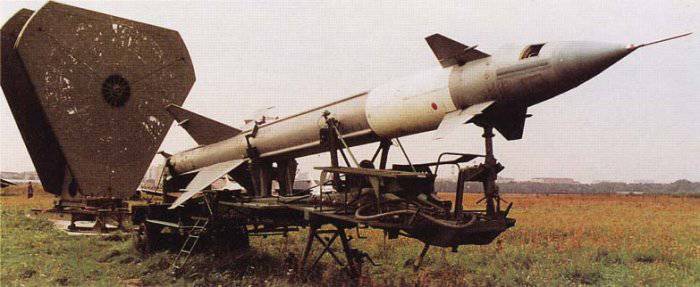
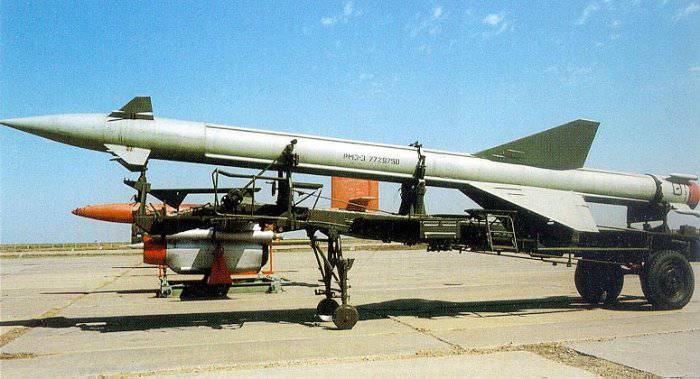
Information